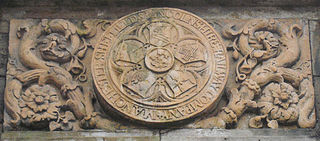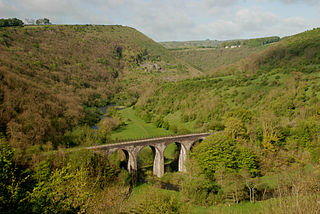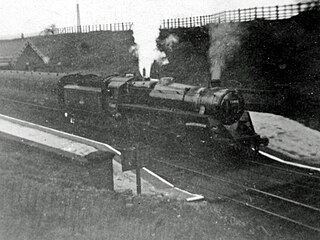
The Midland Railway (MR) was a railway company in the United Kingdom from 1844. The Midland was one of the largest railway companies in Britain in the early 20th century, and the largest employer in Derby, where it had its headquarters. It amalgamated with several other railways to create the London, Midland and Scottish Railway at grouping in 1923.

The Hope Valley line is a trans-Pennine railway line in Northern England, linking Manchester with Sheffield. It was completed in 1894.

The Manchester, Sheffield and Lincolnshire Railway (MS&LR) was formed in 1847 when the Sheffield, Ashton-under-Lyne and Manchester Railway joined with authorised but unbuilt railway companies, forming a proposed network from Manchester to Grimsby. It pursued a policy of expanding its area of influence, especially in reaching west to Liverpool, which it ultimately did through the medium of the Cheshire Lines Committee network in joint partnership with the Great Northern Railway (GNR) and the Midland Railway.

The Cheshire Lines Committee (CLC) was formed in the 1860s and became the second-largest joint railway in Great Britain. The committee, which was often styled the Cheshire Lines Railway, operated 143 miles (230 km) of track in the then counties of Lancashire and Cheshire. The railway did not become part of the Big Four during the implementation of the 1923 grouping, surviving independently with its own management until the railways were nationalised at the beginning of 1948. The railway served Liverpool, Manchester, Stockport, Warrington, Widnes, Northwich, Winsford, Knutsford, Chester and Southport with connections to many other railways.
The Ashton, Stalybridge and Liverpool Junction Railway (AS&LJR) was opened in 1846 to connect the industrial town of Ashton-under-Lyne to the developing railway network, and in particular to the port of Liverpool. It was a short line, joining the Manchester and Leeds Railway at Miles Platting and the connection to Liverpool was over that line and the Liverpool and Manchester Railway.

The Manchester, Buxton, Matlock and Midland Junction Railway ran from a junction with the Midland Railway at Ambergate to Rowsley north of Matlock and thence to Buxton.

Chinley railway station serves the rural village of Chinley in Derbyshire, England. The station is 17+1⁄2 miles (28.2 km) south east of Manchester Piccadilly, on the Hope Valley Line from Sheffield to Manchester. It is unstaffed and is managed by Northern Trains.

Hazel Grove railway station is a junction on both the Stockport to Buxton and Stockport to Sheffield lines, serving the village of Hazel Grove, Greater Manchester, England.

New Mills Central railway station serves the town of New Mills in Derbyshire, England. It is on the Hope Valley Line between Manchester Piccadilly and Sheffield, 12+3⁄4 miles (20.5 km) east of the former. The town is also served by New Mills Newtown station, which is on the Buxton to Stockport and Manchester line.

Dove Holes Tunnel is a tunnel built by the Midland Railway between Peak Forest Signal Box and Chapel-en-le-Frith in Derbyshire in 1860–64, now carrying the Great Rocks Line.

The Buxton line is a railway line in Northern England, connecting Manchester with Buxton in Derbyshire. Passenger services on the line are currently operated by Northern Trains.

Disley Tunnel was built by the Midland Railway in 1902 on its line between New Mills South Junction and Manchester Central, which was more direct than the congested and difficult lines through Stockport Tiviot Dale.
The Stockport and Woodley Junction Railway was incorporated on 15 May 1860 to build a 2 miles 61 chains (4.4 km) railway from Stockport Portwood to a junction with the Manchester, Sheffield and Lincolnshire Railway's (MS&LR) authorised Newton and Compstall line at Woodley.
The Cheshire Midland Railway was authorised by an act of Parliament, passed on 14 June 1860, to build a 12-mile-65-chain (20.6 km) railway from Altrincham on the Manchester, South Junction and Altrincham Railway to Northwich.

The Stockport, Timperley and Altrincham Junction Railway (ST&AJR) was authorised by an act of Parliament, passed on 22 July 1861 to build a 8 miles 17 chains (13.2 km) railway from Stockport Portwood to Altrincham.

Cheadle Heath railway station was a stop on the Midland Railway's New Mills and Heaton Mersey line; it served the suburb of Cheadle Heath in Stockport, Greater Manchester, England.

Hazel Grove (Midland) was a railway station in Hazel Grove, formerly in Cheshire, England; it was in use between 1 July 1902 and 1 January 1917 on the Midland Railway's New Mills to Heaton Mersey line.
The Stockport, Disley and Whaley Bridge Railway was an early railway company in England which was opened in 1857 between Stockport Edgeley and Whaley Bridge.

The South Manchester Line (SML) is a tram line of the Manchester Metrolink in Manchester, England, running from Manchester city centre to Didsbury. The line opened as far as St. Werburgh's Road in 2011 and then to East Didsbury in 2013 as part of phase three of the system's expansion, along a former railway trackbed.

The Manchester South District Railway (MSDR) was a British railway company that was formed in 1873. It was formed by a group of landowners and businessmen in the south of Manchester, England, with the purpose of building a new railway line through the city's southern suburbs.

















